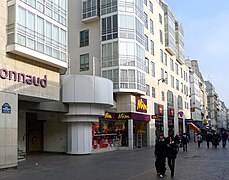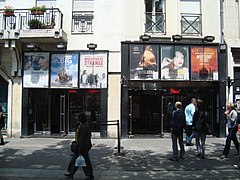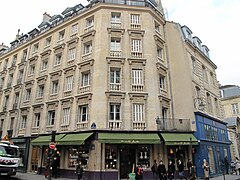
Georges-Eugène Haussmann, commonly known as Baron Haussmann, was a French official who served as prefect of Seine (1853–1870), chosen by Emperor Napoleon III to carry out a massive urban renewal programme of new boulevards, parks and public works in Paris commonly referred to as Haussmann's renovation of Paris. Critics forced his resignation for extravagance, but his vision of the city still dominates central Paris.

The 4th arrondissement of Paris is one of the twenty arrondissements of the capital city of France. In spoken French, this arrondissement is referred to as quatrième. Along with the 1st, 2nd and 3rd arrondissements, it is in the first sector of Paris, which maintains a single local government rather than four separate ones.
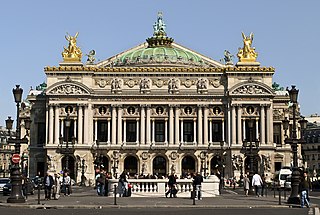
The 9th arrondissement of Paris is one of the 20 arrondissements of the capital city of France. In spoken French, it is referred to as le neuvième.

The 15th arrondissement of Paris is one of the 20 arrondissements of the capital city of France. In spoken French, this arrondissement is referred to as quinzième.

Rambuteau is a station on line 11 of the Paris Métro in the 3rd and 4th arrondissements in central Paris. It is named after the nearby rue Rambuteau, which was named after Claude-Philibert Barthelot, Comte de Rambuteau, a senior official in the former Department of the Seine, who established the groundwork for the fundamental transformation of Paris that Haussmann carried out under the Second Empire.
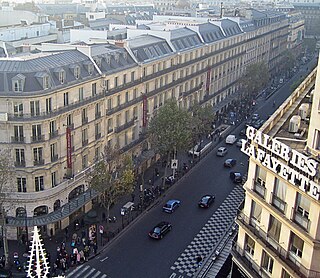
Boulevard Haussmann, 2.53 kilometres (1.57 mi) long from the 8th to the 9th arrondissement, is one of the wide tree-lined boulevards created in Paris by Napoleon III, under the direction of his Prefect of the Seine, Baron Haussmann.

Haussmann's renovation of Paris was a vast public works programme commissioned by Emperor Napoleon III and directed by his prefect of Seine, Georges-Eugène Haussmann, between 1853 and 1870. It included the demolition of medieval neighbourhoods that were deemed overcrowded and unhealthy by officials at the time; the building of wide avenues; new parks and squares; the annexation of the suburbs surrounding Paris; and the construction of new sewers, fountains and aqueducts. Haussmann's work was met with fierce opposition, and he was finally dismissed by Napoleon III in 1870; but work on his projects continued until 1927. The street plan and distinctive appearance of the centre of Paris today are largely the result of Haussmann's renovation.

Parc Montsouris is a public park situated in southern Paris, France. Located in the 14th arrondissement, it was officially inaugurated in 1875 after an early opening in 1869.
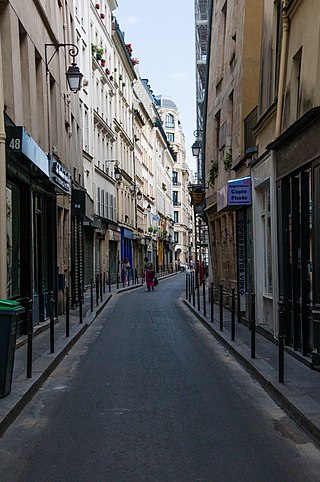
The rue de Montmorency is a street in the historic Le Marais quarter of Paris, part of the city's 3rd arrondissement. It runs from the rue du Temple to the rue Saint-Martin.
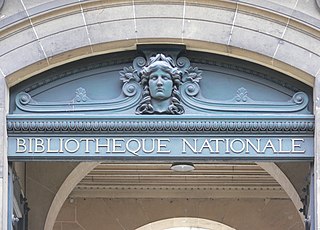
The Rue de Richelieu is a long street of Paris, starting in the south of the 1st arrondissement at the Comédie-Française and ending in the north of the 2nd arrondissement. For the first half of the 19th century, before Georges-Eugène Haussmann redefined Paris with grand boulevards, it was one of the most fashionable streets of Paris.
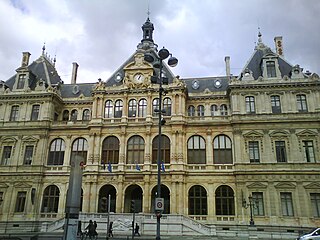
Les Cordeliers is one of the central quarters in the 2nd arrondissement of Lyon, France. It is mainly known for the Place des Cordeliers in its centre. Around the square, there are many notable monuments, including the Église Saint-Bonaventure and the Palais de la Bourse.

Eugène Alfred Hénard was a French architect and a highly influential urban planner. He was a pioneer of roundabouts, which were first introduced in Paris in 1907.
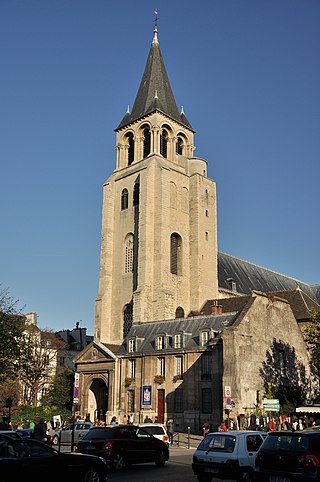
The city of Paris has notable examples of architecture of every period, from the Middle Ages to the 21st century. It was the birthplace of the Gothic style, and has important monuments of the French Renaissance, Classical revival, the Flamboyant style of the reign of Napoleon III, the Belle Époque, and the Art Nouveau style. The great Exposition Universelle (1889) and 1900 added Paris landmarks, including the Eiffel Tower and Grand Palais. In the 20th century, the Art Deco style of architecture first appeared in Paris, and Paris architects also influenced the postmodern architecture of the second half of the century.

The Jardin des Champs-Élysées is a public park located in the 8th arrondissement of Paris. It occupies 13.7 hectares, and is located on both sides of the Avenue des Champs-Élysées between the Place de la Concorde on the east and the Rond-point des Champs-Élysées on the west and between Avenue Gabriel to the north and the Seine to the south. It includes within its boundaries the Grand Palais and the Petit Palais, as well as a theater and other buildings. It was one of the first parks in the city, laid out by André Le Notre in 1667, and was the site of the Paris International Exposition of 1855 and an important part of the Paris Universal Exposition of 1900, for which the Grand Palais and Petit Palais were created.
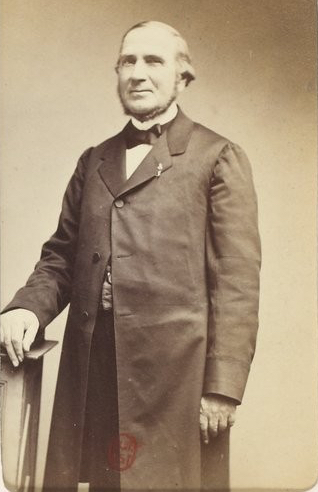
Auguste Prosper Balagny was a French notary and the first mayor of the 17th arrondissement of Paris.
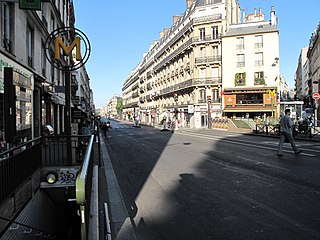
The rue La Fayette is a street in the 9th district and 10th arrondissement of Paris between the rue du Faubourg Saint-Martin and the rue du Faubourg Poissonnière.

Paris during the reign of King Louis-Philippe (1830-1848) was the city described in the novels of Honoré de Balzac and Victor Hugo. Its population increased from 785,000 in 1831 to 1,053,000 in 1848, as the city grew to the north and west, while the poorest neighborhoods in the center became even more crowded.

Paris in the Belle Époque was a period in the history of the city between the years 1871 to 1914, from the beginning of the Third French Republic until the First World War. It saw the construction of the Eiffel Tower, the Paris Métro, the completion of the Paris Opera, and the beginning of the Basilica of Sacré-Cœur on Montmartre. Three lavish "universal expositions" in 1878, 1889, and 1900 brought millions of visitors to Paris to sample the latest innovations in commerce, art, and technology. Paris was the scene of the first public projection of a motion picture, and the birthplace of the Ballets Russes, Impressionism, and Modern Art.
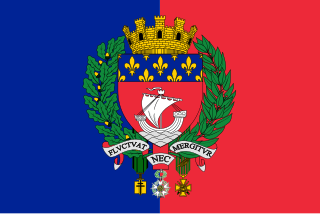
The following outline is provided as an overview of and topical guide to Paris:
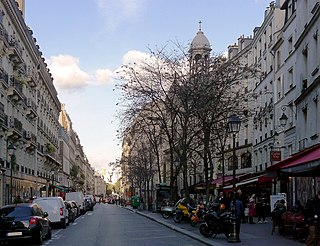
The Rue des Archives is a street in The Marais at the border of 3rd and 4th arrondissements of Paris, France.



